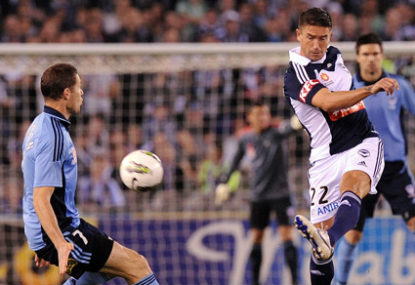“Turnout to prove case,” read the headline from The Mercury newspaper this week, referring to Tasmania hosting the A-League regional round between Melbourne Victory and Gold Coast United and whether the turnout would help justify a club representing the state in the competition.
This was, after all, the first A-League home and away match to be staged in Tassie – at Aurora Stadium, Launceston, potential home for Tasmania United FC, the name of the group pushing for the state’s inclusion in the A-League.
Their fan liaison and social media administrator, Charles Gregory, was quoted in The Mercury saying a crowd of 10,000 will “certainly remind the FFA to keep an eye on us”.
After all, Launceston previously hosted two pre-season matches that pulled crowds of 6307 and 8601. This clash would be a contest for premiership points involving Harry Kewell.
But only 5268 turned up. The 10,000 may have been too great a target (expecting one in every ten Launceston resident to turn up to a match without Tasmanian representation probably a tad optimistic), but the crowd was respectable considering the match, like most of the regional rounds, was scheduled midweek, when even big cities struggle to get fans in on a Wednesday night.
However, whether Tasmania has the population to sustain a club is a legitimate concern, considering the split between the state’s two biggest centres, Launceston and Hobart – two and a half hours drive between them.
Both have adequate stadiums, although while Hobart has the greater population, double that of Launceston, a Hobart-based A-League club will now go head-to-head with the city’s Big Bash League franchise, the Hurricanes. Wasn’t the lack of the sporting competition one of the major advantages of putting an A-League club in the state, helping to negate the small population concern?
According to Tasmania United, “Initially, the club plans to rotate home matches between the north and south of the state. In the north, Aurora Stadium is an obvious choice, having successfully hosted many national and international sporting events, including football.
In the south of the state, options continue to be assessed. North Hobart and Bellerive are obvious choices but the taskforce is considering a variety of short and longer term options.”
The problem here is the schism it creates; the potential division between the two and the lack of identity the club would have if it was forced to pick one over the other (hardly “Tasmania United”).
As the league saw in Townsville, which has a greater population than Launceston, any own goals are amplified when there is such a small population to try and attract a sustainable fan-base from.
There are other concerns. Key to any official bid (which the state government has not committed to) is marrying the Tasmania United taskforce with Football Federation Tasmania, which is yet to happen.
But is the Tasmanian grassroots strong and deep enough to sustain an A-League club, in terms of players, junior coaches and the like?
Remember, although there is no AFL club based in Tassie, Aussie Rules has a strong grassroots presence there, again quashing the idea that round ball football can have a monopoly of the state if it decides to move in with an A-League team.
Then there is money. Minister for Sport and Recreation Brian Wightman recently said he could not commit the $7.5 to 10 million investment needed to create and sustain a potential club over the first five years.
As evidenced by V8 Supercars’ public battle with the Tassie government to save the state’s event with funding for track upgrades at Symmons Plains Raceway in Launceston, the state’s economy is hardly flush with cash for sport.
And if the FFA is unable to find investors willing to back a western Sydney franchise, out of the game’s supposed heartland, what hope is there of a non-government investor for a club out of Tassie, in what would be the smallest market in the league?
Ultimately, proponents of Tasmania United point to the state’s lack of professional sporting teams – no clubs in the main football codes, thanks to the AFL’s continued snubbing, with only the Hurricanes in play.
But, crucially, they will clash in the same time of the year as Tasmania United, should it be based in Hobart.
The question, therefore, that needs to be asked is whether a market so small can sustain two professional sporting clubs going head-to-head in the key summer school holiday period. Advantage Launceston? But what about the smaller population? Again, that old schism remains.
Perhaps a franchise could have worked pre-Big Bash League, getting in before anyone else. But in the time since I last wrote about Tasmania and the A-League, which I was then in favour of, the league has failed to prove it can sustain clubs in chance markets.
Even Central Coast, with all their on-field success, have struggled for financial backing in a market that, in reality, is probably too small for the current A-League economic model.
This whole argument is a moot point, however. Further expansion of the A-League is on the back burner after the recent assessments of the league from the government and governing body, not to mention the continued question marks around the sustainability of Gold Coast United and following the demise of North Queensland Fury.
If it were to expand, then the FFA would also have to consider bigger centres such as Canberra and Wollongong, with previous histories of football clubs in the national competition. And let’s not forget the great, untapped western Sydney, if there is an investor out there.
Despite the football code vacuum that exists on the Apple Isle, there remain some question marks around Tassie and the A-League.





























































































